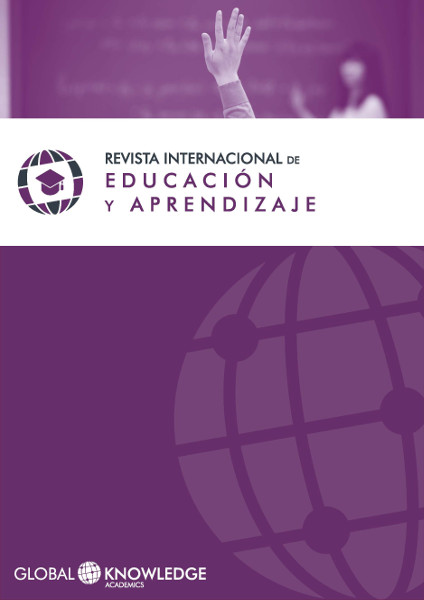Understanding the cultural and situational influences of students versus learning Spanish as a Foreign Language (SFL)
DOI:
https://doi.org/10.37467/gka-revedu.v6.1814Keywords:
Beliefs about Language, Learning, Cultural Differences, Intercultural, Communicative, Competence, IdentityAbstract
Understanding the beliefs that students have regarding learning a foreign language is essential to understand the strategies that the teacher should use to plan an adequate language teaching. This reflective article talks about the perceptions and vision that a group of high school students and other actors have about the learning of Spanish as a Foreign Language (SFL), and this multicultural world where knowing languages is essential. These perceptions and vision will be analysed by the context where they are learning Spanish and by the cultural differences between students themselves and their Spanish teacher. Finally, the conclusions suggest considering the typology of classes taught in SFL for a more inclusive education.
Downloads
Global Statistics ℹ️
|
498
Views
|
254
Downloads
|
|
752
Total
|
|
References
Blake, Robert, & Colombi, María Cecilia (2013). La enseñanza del español para hispanohablantes: Un programa. El español en Estados Unidos: E pluribus unum? Enfoques multidisciplinarios (pp. 291). New York, New York: Academia norteamericana de la lengua.
Cancino, Jorge (2017). «El plan migratorio respaldado por el presidente Trump explicado en 10 puntos: pide saber inglés y cancelaría lotería de visas». Univisión. http://bit.ly/2huEeXc [Consultado el 16-07-2018].
Diccionario de la lengua española. (2018). Estadounidismo. En Diccionario de la lengua española. Recuperado de http://dle.rae.es/?id=GjyFPOD
Diviñó-González, Esther. (2013). “La competencia comunicativa intercultural en la clase multicultural de español como lengua extranjera”. Rastros Rostros 15.29 (2013): 25-35. Impreso. DOI: https://doi.org/10.16925/ra.v15i29.695
Fernández Moreno, F. (1997): «¿Qué español hay que enseñar? Modelos lingüísticos en la enseñanza de español/LE», Cuadernos Cervantes de la Lengua Española, 14: 7-15.
Gómez-Rodríguez, L. F. (2018). EFL Learners’ Intercultural Competence Development Through International News. GiST Education and Learning Research Journal, (16), 185-208. https://doi.org/https://doi.org/10.26817/16925777.431 DOI: https://doi.org/10.26817/16925777.431
Hernández-Nieto, Rosana & Gutiérrez, Marcus. (2017). Mapa hispano de los Estados Unidos – 2017. Informes del Observatorio / Observatorio Reports. 035-11/2017SP. ISSN: 2373-874X (online) doi: 10.15427/OR035-11/2017SP. Instituto Cervantes at FAS - Harvard University. DOI: https://doi.org/10.15427/OR035-11/2017SP
Instituto Cervantes. El español, una lengua viva. Informe 2013. F. Moreno Fernández (Dir.). Madrid: Instituto Cervantes, 2013.
Lipski, J. (2013). “Hacia una dialectología del español estadounidense”. En El español en los Estados Unidos: E pluribus unum? Enfoques multidisciplinarios, eds. D. Dumitrescu y G. Piña-Rosales, 107–27. Nueva York: Academia Norteamericana de la Lengua Española.
Lipski, John M. (2008). Varieties of Spanish in the United States. Washington, District of Columbia: Georgetown University Press.
Liu, Y.-F. C. (2016). Cultural Collision: The Interference of First Language Cultural Identity on Pragmatic Competence of the Target Language. GiST Education and Learning Research Journal, (13), 131-147. https://doi.org/https://doi.org/10.26817/16925777.323 DOI: https://doi.org/10.26817/16925777.323
Lynch, A. & Potowski, K. (2014). “La valoración del habla bilingüe en los Estados Unidos: Fundamentos sociolingüístico y pedagógicos en Hablando bien se entiende la gente. Hispania, Volume 97, Number 1, pp. 32-46. DOI: https://doi.org/10.1353/hpn.2014.0025
Manel Lacorte & Jesús Suárez García. (2014) La enseñanza del español en los Estados Unidos: panorama actual y perspectivas de futuro. Journal of Spanish Language Teaching 1:2, pages 129-136. DOI: https://doi.org/10.1080/23247797.2014.970358
Moeller, A. K. and Nugent, K. (2014). Building intercultural competence in the language classroom. Faculty Publications: Department of Teaching, Learning and Teacher Education. Paper 161. http://digitalcommons.unl.edu/teachlearnfacpub/161
Moreno Fernández, F. (2013). “Panorama interdisciplinario del español en los Estados Unidos”. Tribuna Norteamericana 14: 1–6.
Ormeño, V. & Rosas, M. (2015). Creencias acerca del aprendizaje de una lengua extranjera en un programa de formación inicial de profesores de inglés en Chile. Colombian. Appl. Linguist. J., 17(2), pp. 207-228. DOI: https://doi.org/10.14483/udistrital.jour.calj.2015.2.a03
Piña-Rosales, Gerardo, Covarrubias, Jorge I., Dumitrescu, Domnița, & ANLE, Academia Norteamericana de la Lengua Española (2014). Hablando bien se entiende la gente 2: Recomendaciones idiomáticas de la Academia Norteamericana de la Lengua Española. Doral, Florida: Santillana USA.
Reznicek – Parrado Lina. (2015). “Spanglish”: Bringing the academic debate into the classroom. Towards critical pedagogy in Spanish heritage instruction. E-JournALL, EuroAmerican Journal of Applied Linguistics and Languages Special Issue, Volume 2, Issue 2, December 2015, pages 50-66 ISSN 2376-905X DOI http://dx.doi.org/10.21283/2376905X.3.51 DOI: https://doi.org/10.21283/2376905X.3.51
Rhodes, N. & Pufahl, I. (2014). Panorama de la enseñanza de español en las escuelas de los Estados Unidos. Resultado de la encuesta nacional. Informes del Observatorio / Observatorio Reports. ISSN: 23723874X (online) DOI: 10.15427/OR002-06/2014SP, Instituto Cervantes at FAS - Harvard University. DOI: https://doi.org/10.15427/OR002-06/2014SP
Rodriguez-Bonces, M. (2003). Culture in the Classroom. HOW Magazine. Number 10. ISSN 0120-5927. Bogota: ASOCOPI.
Usó, L. (2013). Pronunciación en lengua extranjera e identidad. Cultura, lenguaje y representación / culture, language and representation ˙ issn 1697-7750 · vol. xi 2013, pp. 145-163. Revista de estudios culturales de la universitat jaume i / cultural studies journal of universitat jaume i. Doi: http://dx.doi.org/10.6035/clr.2013.11.9 DOI: https://doi.org/10.6035/CLR.2013.11.9
Williams & Burden (1999): Psicología para profesores de idiomas. Enfoque del constructivismo social, Madrid, CUP.
Downloads
Published
How to Cite
Issue
Section
License
Those authors who publish in this journal accept the following terms:
-
Authors retain copyright.
-
Authors transfer to the journal the right of first publication. The journal also owns the publishing rights.
-
All published contents are governed by an Attribution-NoDerivatives 4.0 International License.
Access the informative version and legal text of the license. By virtue of this, third parties are allowed to use what is published as long as they mention the authorship of the work and the first publication in this journal. If you transform the material, you may not distribute the modified work. -
Authors may make other independent and additional contractual arrangements for non-exclusive distribution of the version of the article published in this journal (e.g., inclusion in an institutional repository or publication in a book) as long as they clearly indicate that the work was first published in this journal.
- Authors are allowed and recommended to publish their work on the Internet (for example on institutional and personal websites), following the publication of, and referencing the journal, as this could lead to constructive exchanges and a more extensive and quick circulation of published works (see The Effect of Open Access).













